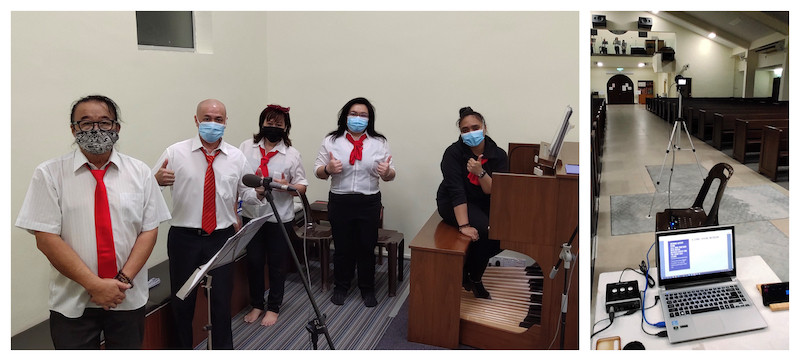PETALING JAYA, December 18 — Carolling from one house to another is one of the best parts of the Christmas season.
Singing carols with friends is something many look forward to especially nearing the Christmas season.
It obviously is a different Christmas this time around, with carollers from many churches performing for the congregation via livestreaming amid the Covid-19 pandemic.
Virtual carolling is a new term to digest especially since it involves learning to use recording devices at homes without the usual merriment of having everyone around to sing in a group.
Malay Mail spoke to choir representatives from Seremban’s St Mark’s Anglican church and Sabah’s St. Simon’s Catholic Church to ask them about singing via online platforms.
Choosing the best choristers
Having a small number of choristers to practice with, put a slight damper on the Christmas spirit.
For Elvy John Ansibin, assistant choir leader who attends the St Simon Catholic Church in Kota Kinabalu, Sabah, the feeling of transitioning to online platforms was unusual at the beginning.
“From singing in a group to singing to recording devices definitely felt strange in the beginning as we didn’t have a proper audience to share the same joy with us.”
The choir moved online as it was the parish priest’s initiative to bring its parishioners together to have the community spirit and sense of belonging amid the pandemic.
“We have been so used to singing in a group with 44 people and bringing this joy to church goers, but this time it has been different with a smaller crowd of choristers.
“Because of the strict measures that don’t allow all 44 of us to meet in church at one time, we had to bring down the number to just four of them together with one musician.
“As such, we choose the best chorister to represent each vocal range group and sometimes it can be difficult when we have to do our solo parts as we are alone and have to reach the notes on our own.”
The selection process was done based on its seniority and on the ones who had better sight reading skills.
Elvy added that for some of the songs, it was difficult for the choristers to sing their parts as they were the only ones representing their vocal range group.
To overcome this, a lot of practice has to be done by the team and in their own homes before the songs are live-streamed.
“We took a lot of time off to come to church to practise the songs and make sure that no one was off beat and we made sure each one of us practised hard enough as we represented each vocal range group.”
From contemporary songs to traditional Christmas hymns
For St Mark’s Anglican church in Seremban, the choir group consisting mainly of youths which was used to singing both contemporary and hymns, had to adjust to singing only hymns for their virtual carolling.
According to choral advisor Maria Thomas, she said that because some contemporary Christmas songs that are new and the choristers were afraid to broadcast the songs without obtaining copyright permission.
“We didn’t want to take the risk of singing newer songs without proper copyright permission.
“Our choir group then decided to sing hymns such as Silent Night, Angels We Have Heard on High and Away in a Manger because these hymns were older.”
“And also sing other traditional carols that are at least 100 years old.”
A group of us brainstormed on a selected list of Christmas carols that most people would love to listen to online and selected 12 songs including two Tamil carols Nal Yesu Piranthare and Vanavar.
“It was a refreshing experience for the audience which were social media users including our church members who praised us for virtual carolling and incorporating the songs that they like listening to.”
Recording from home and putting it all together
Virtual carolling needs to be complemented with mastering the art of using the right recording devices at home.
And sometimes, that requires a little more motivation from choir members especially since most of them had to do their singing in their homes for the pre-recorded Christmas carols.
Maria said that initially some of the choristers found it demotivating to record their songs at home because they had to take note of such devices such as their phones or cameras to record themselves and another one to listen to the music while singing.
“This happened sometime from September to October where the 14 choristers had to juggle between their online classes which was difficult to get them to send in their pre-recorded songs of themselves singing.
“When we asked the choir members whether they still wanted to continue singing and recording for Christmas, all of them said yes.
“So that was when we met in November, choristers came in batches where two of the youth members recorded them singing.”
The hardest part was combining the songs and putting them in a video format.
“One of the choristers Jeremy however managed to put all of it together in a video after undergoing a two-week online course on virtual choir.
“It was a fun experience for all of us experiencing this virtual choir as we could still perform on a virtual platform, although not as fun as being together and singing in a group.”
The choristers have sung nine songs and will put up the last three songs on their church’s online platform.






















